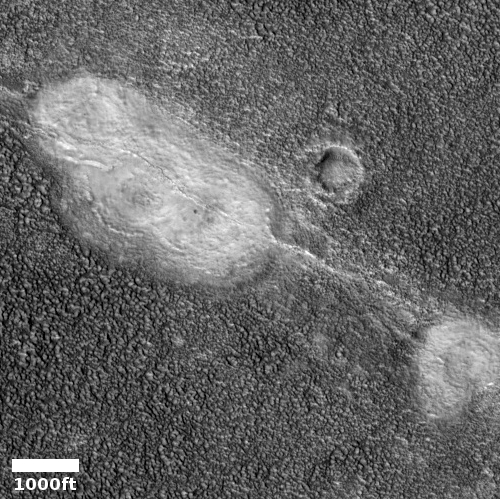White blobs on Mars
Time for another “What the heck?” image. The photo to the right, cropped to post here, was taken on May 18, 2021 by the high resolution camera on Mars Reconnaissance Orbiter (MRO). It shows what appears to be a series of white circular features aligned with a ridge line.
Are these eroded craters? Maybe, but their alignment with those ridges suggests otherwise. If you look at the full image, you will see further parallel ridges to the north and south, also with similar circular blobs lined along them. Furthermore, the flat surrounding terrain, part of the northern lowland plains north of the resurgences from Valles Marineris, has a scattering of very normal looking craters, with distinct rims and even some glacial material within. As this is at 44 degrees north latitude, the presence of glacial material inside craters is not surprising.
Thus, the white blobs are likely not craters, but some form of eruptive material from below, coming up along those ridges which are probably faultlines. The whiteness suggests that material is water ice, but this of course is unconfirmed.
The question is of course, why? What would cause water ice to erupt along these faultlines? And why are such features not seen elsewhere? Faults and underground ice are common on Mars. Yet, I don’t remember seeing features such as this in any other Martian images.
On Christmas Eve 1968 three Americans became the first humans to visit another world. What they did to celebrate was unexpected and profound, and will be remembered throughout all human history. Genesis: the Story of Apollo 8, Robert Zimmerman's classic history of humanity's first journey to another world, tells that story, and it is now available as both an ebook and an audiobook, both with a foreword by Valerie Anders and a new introduction by Robert Zimmerman.
The print edition can be purchased at Amazon or from any other book seller. If you want an autographed copy the price is $60 for the hardback and $45 for the paperback, plus $8 shipping for each. Go here for purchasing details. The ebook is available everywhere for $5.99 (before discount) at amazon, or direct from my ebook publisher, ebookit. If you buy it from ebookit you don't support the big tech companies and the author gets a bigger cut much sooner.
The audiobook is also available at all these vendors, and is also free with a 30-day trial membership to Audible.
"Not simply about one mission, [Genesis] is also the history of America's quest for the moon... Zimmerman has done a masterful job of tying disparate events together into a solid account of one of America's greatest human triumphs."--San Antonio Express-News
Time for another “What the heck?” image. The photo to the right, cropped to post here, was taken on May 18, 2021 by the high resolution camera on Mars Reconnaissance Orbiter (MRO). It shows what appears to be a series of white circular features aligned with a ridge line.
Are these eroded craters? Maybe, but their alignment with those ridges suggests otherwise. If you look at the full image, you will see further parallel ridges to the north and south, also with similar circular blobs lined along them. Furthermore, the flat surrounding terrain, part of the northern lowland plains north of the resurgences from Valles Marineris, has a scattering of very normal looking craters, with distinct rims and even some glacial material within. As this is at 44 degrees north latitude, the presence of glacial material inside craters is not surprising.
Thus, the white blobs are likely not craters, but some form of eruptive material from below, coming up along those ridges which are probably faultlines. The whiteness suggests that material is water ice, but this of course is unconfirmed.
The question is of course, why? What would cause water ice to erupt along these faultlines? And why are such features not seen elsewhere? Faults and underground ice are common on Mars. Yet, I don’t remember seeing features such as this in any other Martian images.
On Christmas Eve 1968 three Americans became the first humans to visit another world. What they did to celebrate was unexpected and profound, and will be remembered throughout all human history. Genesis: the Story of Apollo 8, Robert Zimmerman's classic history of humanity's first journey to another world, tells that story, and it is now available as both an ebook and an audiobook, both with a foreword by Valerie Anders and a new introduction by Robert Zimmerman.
The print edition can be purchased at Amazon or from any other book seller. If you want an autographed copy the price is $60 for the hardback and $45 for the paperback, plus $8 shipping for each. Go here for purchasing details. The ebook is available everywhere for $5.99 (before discount) at amazon, or direct from my ebook publisher, ebookit. If you buy it from ebookit you don't support the big tech companies and the author gets a bigger cut much sooner.
The audiobook is also available at all these vendors, and is also free with a 30-day trial membership to Audible.
"Not simply about one mission, [Genesis] is also the history of America's quest for the moon... Zimmerman has done a masterful job of tying disparate events together into a solid account of one of America's greatest human triumphs."--San Antonio Express-News



They’re probably mud volcanoes. Sediments that were under subsurface pressure released along a fault line,
Bill Farrand: Makes sense. It is also what I proposed. But why so white? And they look very different than any other theorized mud volcanoes I’ve seen in other Mars pictures. For example, they show little or no vertical topography.